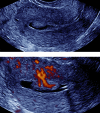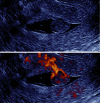Intra-cavitary uterine pathology in women with abnormal uterine bleeding: a prospective study of 1220 women
- PMID: 25897368
- PMCID: PMC4402439
Intra-cavitary uterine pathology in women with abnormal uterine bleeding: a prospective study of 1220 women
Abstract
Objectives: Our primary aim was to assess how patients' characteristics, bleeding pattern, sonographic endometrial thickness (ET) and additional features at unenhanced ultrasound examination (UTVS) and at fluid instillation sonography (FIS) contribute to the diagnosis of intracavitary uterine pathology in women presenting with abnormal uterine bleeding (AUB). We further aimed to report the prevalence of pathology in women presenting with AUB.
Methods: 1220 consecutive women presenting with AUB underwent UTVS, colour Doppler imaging (CDI) and FIS. Most women (n = 1042) had histological diagnosis.
Results: Mean age was 50 years and 37% were postmenopausal. Of 1220 women 54% were normal, polyps were diagnosed in 26%, intracavitary fibroids in 11%, hyperplasia without atypia in 4% and cancer in 3%. All cancers were diagnosed in postmenopausal (7%) or perimenopausal (1%) women. ET had a low predictive value in premenopausal women (LR+ and LR- of 1.34 and 0.74, respectively), while FIS had a LR+ and LR- of 6.20 and 0.24, respectively. After menopause, ET outperformed all patient characteristics for the prediction of endometrial pathology (LR+ and LR- of 3.13 and 0.24). The corresponding LR+ and LR- were 10.85 and 0.71 for CDI and 8.23 and 0.26 for FIS.
Conclusion: About half of the women presenting to a bleeding clinic will have pathology. In premenopausal women, benign lesions are often the cause of AUB. For the prediction of intracavitary pathology ET is of little value in premenopausal women. CDI and FIS substantially improve the diagnostic accuracy.
Keywords: Ultrasonography; endometrial cancer; leiomyoma; metrorrhagia; polyps.
Figures




Similar articles
-
Ultrasound features of endometrial pathology in women without abnormal uterine bleeding: results from the International Endometrial Tumor Analysis study (IETA3).Ultrasound Obstet Gynecol. 2022 Aug;60(2):243-255. doi: 10.1002/uog.24910. Ultrasound Obstet Gynecol. 2022. PMID: 35385178
-
Typical ultrasound features of various endometrial pathologies described using International Endometrial Tumor Analysis (IETA) terminology in women with abnormal uterine bleeding.Ultrasound Obstet Gynecol. 2021 Jan;57(1):164-172. doi: 10.1002/uog.22109. Ultrasound Obstet Gynecol. 2021. PMID: 32484286
-
Combination of B-Mode Ultrasound and Doppler Ultrasound in Approaching to Uterine Intracavitary Pathologies Among Women Above 40 Years with Abnormal Uterine Bleeding: A Multicenter-Based Study from Vietnam.J Midlife Health. 2022 Apr-Jun;13(2):145-151. doi: 10.4103/jmh.jmh_93_22. Epub 2022 Sep 16. J Midlife Health. 2022. Retraction in: J Midlife Health. 2022 Jul-Sep;13(3):266. doi: 10.4103/0976-7800.367765. PMID: 36276626 Free PMC article. Retracted.
-
Structured imaging technique in the gynecologic office for the diagnosis of abnormal uterine bleeding.Best Pract Res Clin Obstet Gynaecol. 2017 Apr;40:23-43. doi: 10.1016/j.bpobgyn.2016.09.010. Epub 2016 Oct 1. Best Pract Res Clin Obstet Gynaecol. 2017. PMID: 27818130 Review.
-
Ultrasonographic evaluation of the endometrium in postmenopausal vaginal bleeding.Radiol Clin North Am. 2003 Jul;41(4):769-80. doi: 10.1016/s0033-8389(03)00060-5. Radiol Clin North Am. 2003. PMID: 12899491 Review.
Cited by
-
Association of Endometrial Cancer Risk With Postmenopausal Bleeding in Women: A Systematic Review and Meta-analysis.JAMA Intern Med. 2018 Sep 1;178(9):1210-1222. doi: 10.1001/jamainternmed.2018.2820. JAMA Intern Med. 2018. PMID: 30083701 Free PMC article.
-
Detection and Classification of Hysteroscopic Images Using Deep Learning.Cancers (Basel). 2024 Mar 28;16(7):1315. doi: 10.3390/cancers16071315. Cancers (Basel). 2024. PMID: 38610993 Free PMC article.
-
Developing a Preoperative Algorithm for the Diagnosis of Uterine Leiomyosarcoma.Diagnostics (Basel). 2020 Sep 23;10(10):735. doi: 10.3390/diagnostics10100735. Diagnostics (Basel). 2020. PMID: 32977421 Free PMC article.
-
The relationship between endometrial thickening and endometrial lesions in postmenopausal women.Arch Gynecol Obstet. 2022 Dec;306(6):2047-2054. doi: 10.1007/s00404-022-06734-7. Epub 2022 Aug 25. Arch Gynecol Obstet. 2022. PMID: 36006486
-
Three-dimensional saline infusion sonography compared to two-dimensional saline infusion sonography for the diagnosis of focal intracavitary lesions.Cochrane Database Syst Rev. 2017 May 5;5(5):CD011126. doi: 10.1002/14651858.CD011126.pub2. Cochrane Database Syst Rev. 2017. PMID: 28472862 Free PMC article.
References
-
- Amant F, Moerman P, Neven P, et al. Endometrial cancer. Lancet. 2005;366:491–505. - PubMed
-
- Bignardi T, Van den Bosch T, Condous G. Abnormal uterine and post-menopausal bleeding in the acute gynaecology unit. Best Pract Res Clin Obstet Gynaecol. 2009;23:595–607. - PubMed
-
- Breijer MC, Peeters JA, Opmeer BC, et al. Capacity of endometrial thickness measurement to diagnose endometrial carcinoma in asymptomatic postmenopausal women: a systematic review and meta-analysis. Ultrasound Obstet Gynecol. 2012;40:621–629. - PubMed
-
- Clark TJ, Barton PM, Coomarasamy A, et al. Investigating postmenopausal bleeding for endometrial cancer: cost-effectiveness of initial diagnostic strategies. BJOG. 2006;113:502–510. - PubMed
-
- de Kroon C, De Bock GH, Dieben SWM, et al. Saline contrast hydrosonography in abnormal uterine bleeding: a systematic review and meta-analysis. BJOG. 2003;110:938–947. - PubMed
LinkOut - more resources
Full Text Sources
